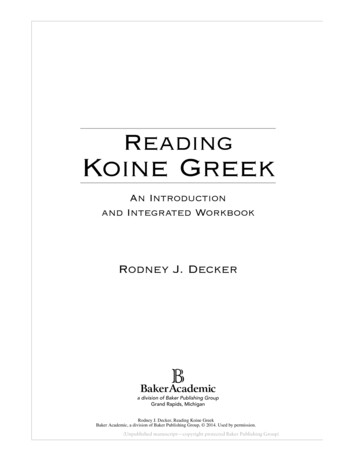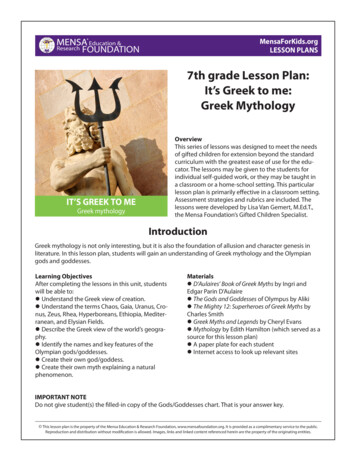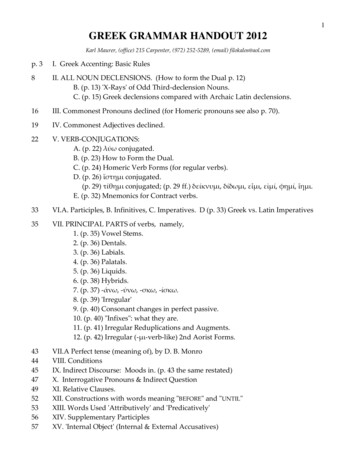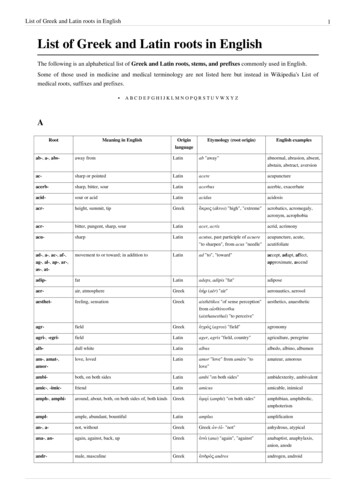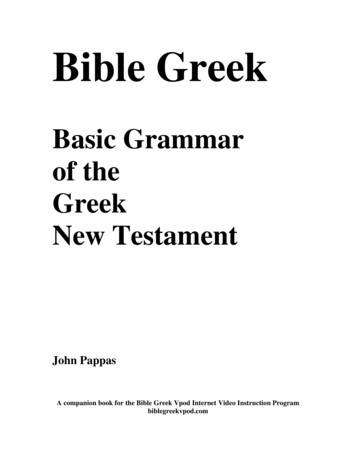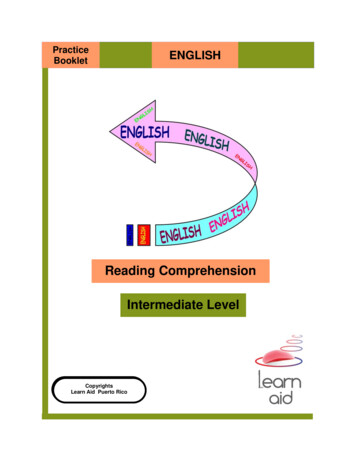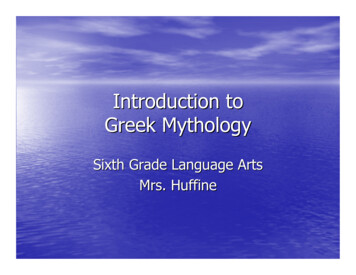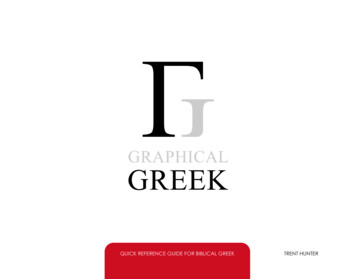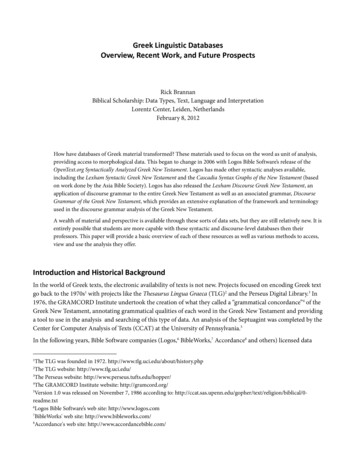
Transcription
Greek Linguistic DatabasesOverview, Recent Work, and Future ProspectsRick BrannanBiblical Scholarship: Data Types, Text, Language and InterpretationLorentz Center, Leiden, NetherlandsFebruary 8, 2012How have databases of Greek material transformed? These materials used to focus on the word as unit of analysis,providing access to morphological data. This began to change in 2006 with Logos Bible Software’s release of theOpenText.org Syntactically Analyzed Greek New Testament. Logos has made other syntactic analyses available,including the Lexham Syntactic Greek New Testament and the Cascadia Syntax Graphs of the New Testament (basedon work done by the Asia Bible Society). Logos has also released the Lexham Discourse Greek New Testament, anapplication of discourse grammar to the entire Greek New Testament as well as an associated grammar, DiscourseGrammar of the Greek New Testament, which provides an extensive explanation of the framework and terminologyused in the discourse grammar analysis of the Greek New Testament.A wealth of material and perspective is available through these sorts of data sets, but they are still relatively new. It isentirely possible that students are more capable with these syntactic and discourse-level databases then theirprofessors. This paper will provide a basic overview of each of these resources as well as various methods to access,view and use the analysis they offer.Introduction and Historical BackgroundIn the world of Greek texts, the electronic availability of texts is not new. Projects focused on encoding Greek textgo back to the 1970s1 with projects like the Thesaurus Lingua Graeca (TLG)2 and the Perseus Digital Library.3 In1976, the GRAMCORD Institute undertook the creation of what they called a “grammatical concordance”4 of theGreek New Testament, annotating grammatical qualities of each word in the Greek New Testament and providinga tool to use in the analysis and searching of this type of data. An analysis of the Septuagint was completed by theCenter for Computer Analysis of Texts (CCAT) at the University of Pennsylvania.5In the following years, Bible Software companies (Logos,6 BibleWorks,7 Accordance8 and others) licensed data1The TLG was founded in 1972. http://www.tlg.uci.edu/about/history.phpThe TLG website: http://www.tlg.uci.edu/3The Perseus website: http://www.perseus.tufts.edu/hopper/4The GRAMCORD Institute website: http://gramcord.org/5Version 1.0 was released on November 7, 1986 according to: lical/0readme.txt6Logos Bible Software’s web site: http://www.logos.com7BibleWorks' web site: http://www.bibleworks.com/8Accordance's web site: http://www.accordancebible.com/2
from GRAMCORD, from Timothy and Barbara Friberg,9 James Tauber,10 and from Maurice A. Robinson andWilliam G. Pierpont.11 Soon software providers began to undertake their own analyses of the grammar of theGreek New Testament.Analysis, while still at the word level, began to expand in scope. The GRAMCORD analysis began to associate anoun case notation with prepositions. This was a method to associate the prepositional object with itspreposition, even if they were not adjacent. Additionally, analyses began to move from providing a strict analysis(e.g. “conjunction”) to providing further information on types and classes of things (e.g. “conjunction,coordinating, copulative”). Analysis began to take on a subjective, instance-based nature. Classification thusbegan to be morpho-syntactic.Other innovations were made as well, though all still essentially at the level of the word. The Friberg analysisdevised a system of ' ' and '-' notation to connect some terms that function together as a pair:A plus sign ( ) immediately before or after a tag indicates a close relationship between the word associated with thetag and another word, as in cases of verbal periphrastics. The sign appears on the side of the tag on which thepairing occurs. A minus sign (-) precedes a relative pronoun tag when there is no overt antecedent in the text.12The parties creating these annotations were bumping against the boundary of the word, trying to get past it butstill constrained by its limits.Recent Work in Linguistic Annotation of the Greek New TestamentIn the early years of the 21st century, Stanley Porter, Jeffrey T. Reed, Matthew Brook O'Donnell, Randall Tan andCatherine Smith commenced the OpenText.org project.13 It was formally introduced on the OpenText.org website on September 22, 2005.14 Details of the analysis had been published earlier in various sources includingconference papers and published dissertations.15Logos Bible Software released an implementation of the OpenText.org Syntactically Analyzed Greek New Testamentin 2006. The previous year we had commenced work on the Lexham Syntactic Greek New Testament,16 an analysistaking a traditional approach much like Reed-Kellogg stick diagramming, the initial portion of this analysis(Hebrews through Jude) was also released in 2006.17 This analysis of the New Testament was completed in 2010.In the mid-2000s, the Perseus project began to create treebanks of Latin and Greek material, now known as The9Timothy and Barbara Friberg's analysis of the Greek New Testament was published in print as the Analytical Greek NewTestament, published by Baker Book House in 1980.10James Tauber's edit and revision of CCAT's Greek New Testament work: http://morphgnt.org11Robinson's byztxt.com site: http://byztxt.com/download/index.html12Barbara Friberg et al., vol. 1, Analytical Greek New Testament : Greek Text Analysis (, Baker's Greek New TestamentlibraryCedar Hill, Texas: Silver Mountain Software, 2001). This system is more fully explained in appendix 3.8 of the book.13The project web site (http://www.opentext.org) has a copyright date of 1998-2005; however the earliest article available onthe site is dated January 11, 2001. ew Brook O'Donnell, “Introducing the OpenText.org Syntactically Analyzed Greek New s/a8.html Accessed: January 18, 2012.15Dissertations include those of Jeffrey T. Reed, A Discourse Analysis of Philippians (1997) and Matthew Brook O'Donnell,Corpus Linguistics and the Greek of the New Testament (2005).16More info here: http://blog.logos.com/2005/12/greek syntax in/ Product page at NT17Logos also released a syntactic analysis of the Hebrew Bible in 2006: The Hebrew Bible: Andersen-Forbes Phrase MarkerAnalysis.
Ancient Greek and Latin Dependency Treebanks.18 While both the Iliad and the Odyssey have been analyzed, theGreek New Testament has not been analyzed.In March of 2008, Logos released the Lexham Discourse Greek New Testament and its counterpart, the HighDefinition New Testament: ESV Edition.19 This applies discourse grammar according to the framework of StephenH. Levinsohn and Steven Runge to the entire text of the Greek New Testament. It identifies devices that workabove the word level as well as implementing a propositional outline of the entire Greek New Testament. In 2010Logos released a grammar explaining the framework called Discourse Grammar of the Greek New Testament.20 Itwas also published in print by Hendrickson Publishers. A video series explaining the concepts has been releasedas well.21In November 2009, Logos released the Cascadia Syntax Graphs of the New Testament, derived from a dynamictreebank project developed by the Asia Bible Society.22 This analysis is unique in that it is built upon a computerreadable Greek grammar that is used by a parser to generate syntactic trees. These trees are reviewed, correctedand refined through an editorial process; the corrections and edits become a knowledgebase that informs theparser on future editions. In November 2010, the Cascadia Syntax Graphs of the New Testament: SBL Edition wasreleased, offering analysis of a different edition of the Greek New Testament. In January 2012, after receivingupdated analysis data from the editors, Logos released significant updates to both of these syntactic analyses.In March of 2010, the PROIEL23 project announced that it had annotated the gospels of the Greek NewTestament.24 As of the writing of this paper (January 2012), the PROIEL annotation looks to also include data forActs and the Pauline epistles, with the balance of the Greek New Testament under review.25In November of 2010, Oak Tree Software released the first portion of a grammatical and syntactical analysis ofthe Hebrew Bible and the Greek New Testament for the Accordance program.26In January of 2012, Jana E. Beck released a demonstration edition of a syntactic annotation of the Gospel ofMatthew. It is part of a larger project, the Penn Parsed Corpora of Historical Greek.27These databases28 were and are revolutionary because they put the focus of analysis beyond simple annotation of18“The Ancient Greek and Latin Dependency Treebanks,” http://nlp.perseus.tufts.edu/syntax/treebank/ Accessed January 24,2012.19Announcement: http://blog.logos.com/2008/03/study the nt like never before/ Product page at -discourse-greek-new-testament-bundle20Product page at Logos.com: on-for-teaching-and-exegesis21Introducing New Testament Discourse Grammar. testamentdiscourse-grammar-video-series22Wu, Andi, and Randall Tan. Cascadia Syntax Graphs of the New Testament. Logos Bible Software, 2009.23“PROIEL: Pragmatic Resources in Old Indo-European search/projects/proiel/ Accessed January 24, 2012.24“[Corpora-List] New Testament corpus,” 0402.html AccessedJanuary 24, 2012.25This analysis uses Tischendorf ’s Eighth edition of the Greek New Testament, prepared by Dr. Maurice A. Robinson withmorphology integrated and edited by Dr. Ulrik Sandborg-Petersen. Online: http://files.morphgnt.org/tischendorf/26Product page at AccordanceBible.com: http://www.accordancebible.com/store/details/?pid GNT-T.syntax . As of February2012, data for the New Testament is complete.27More information available at: http://www.ling.upenn.edu/ janabeck/greek-corpora.html28The week this paper was presented I was made aware of another syntactic analysis of the Greek New Testament, Dr. UlrikSandborg-Petersen. I will update this portion once I have the available information.
words and enabled database users to consider higher level structures (phrases, clauses, and sentences) built upfrom the word level data.However, these sorts of databases are also inherently complex: Complex to understand the frameworks thatproduced them. Complex to display the information to users of the databases. Complex to enable searching of themyriad relationships and structures within the databases. Complex to translate exegetical and grammaticalconcepts routinely found in commentaries and exegesis of the New Testament into terminology and conceptsused in the databases.Syntactic Database Requirements: Seeing and SearchingWhile there are problems with simply annotating syntactic data, once one has a syntactic analysis one has thefurther problems of searching through the data, and of seeing (or visualizing) the data. In order for people to usea syntactic database, they need to have some idea of the features it annotates, the text the annotations apply to,and the relationships between each feature.29In our work on syntactic analyses of the Hebrew Bible and the Greek New Testament, we have found that in orderto have any hope of actually using a syntactic analysis, users need to be able to see something that visuallyrepresents the relationships and structures encoded in an analysis. When they have a picture, they can begin tounderstand and work with the analysis. With a text that only annotates morphological information, this isrelatively simple using either popups on hover, an interlinear display, or both. With a text that could have manylayers of analysis, however, simple text has limitiations.Seeing the DataIn 2005, when Logos was beginning our work on syntactic databases, we had the good fortune of becomingfamiliar with the work of Francis I. Andersen and Dean A. Forbes, particularly with their work in using directedacyclical graphs30 to visualize the relationships in the Andersen-Forbes Phrase Marker Analysis (AFPMA). As thevisualizations of their analysis relied on these sorts of graphs, it was necessary to implement this solution toproperly handle the visualization of their data. Once the capability was available we decided to apply the samevisualization to our available Greek data (at that time the OpenText.org analysis) to see if the benefits of thedirected graph approach would carry over.In a blog post from November 2005, my colleague Eli Evans described a directed graph, and gave some examples:A graph is a convenient way to show connections between things. Flow charts, for example, are a specialized kind ofgraph. So are corporate organizational charts. Sometimes people draw graphs when they are brainstorming, by puttingwords in little bubbles and then drawing lines between them to connect them. When you put arrows on the lines, you’re making a directed graph, which is especially useful for making things likeflowcharts and corporate org charts. This sort of arrangement is also useful for labeling the parts of a clause:29I work for Logos and have extensive knowledge of the Greek syntactic analyses produced for Logos Bible Software. Myexamples will only refer to analyses available from Logos Bible Software. There are other options (e.g. Oak Tree Software’sanalysis in Accordance), but as I am unfamiliar with these options I will not be able to explain or discuss them in detail.30An explanation of the use of graphs for syntax data in Logos Bible Software is available in a series of blog posts:“What’s a Syntax Graph Anyway?”: http://blog.logos.com/2005/11/whats a syntax/“Syntax: Why Graphs?”: http://blog.logos.com/2005/11/syntax why grap/“Syntax: Why Graphs? Part II”: http://blog.logos.com/2005/11/syntax why grap 1/
This is a fine way to diagram a sentence; but while it works well for short sentences, this presentation does not lend itselfwell to displaying entire texts, such as the Bible. If, however, we turn the graph on its side so that the text reads from topto bottom along the right-hand margin, we get a graph like this:Now we can have an infinitely long running text that reads from top to bottom, and that’s just what we have when welook at a Logos Bible Software syntax graph.31The above is both a directed graph and a tree. While trees are nice in the laboratory, when language is out in thewild, it is not always so easy. There are places where an analysis may “tangle” its lines. Trees (like the above) tendto avoid tangling in their presentation. When tangling occurs, there are two choices: rearrange he words, or reanalyze the text.In Andersen and Forbes’ application of directed acyclical graphs, the text is allowed to run in its text order (fromtop to bottom) and the graphs are allowed to tangle as necessary to represent the structures of the language. Onecomplex example is found in Genesis 1.5, which shows a multi-dominant structure:32So supporting the concept of directed acyclical graphs allows the Logos Bible Software representation to reflect,in a visual manner, the complexity of the language as analyzed.While the Andersen-Forbes Phrase Marker Analysis takes full advantage of these capabilities, other syntax analysesdo not. The analyses of the Greek New Testament do at times “tangle,” but they do not express multidominance as3132Eli Evans, “What’s a Syntax Graph Anyway?” http://blog.logos.com/2005/11/whats a syntax/ Accessed January 23, 2012.Eli Evans, “Syntax: Why Graphs? Part II” http://blog.logos.com/2005/11/syntax why grap 1/ Accessed January 23, 2012.
AFPMA does. Below is an example from the OpenText.org Syntactically Analyzed Greek New Testament of Luke2.19, with a postpositive δε and some further tangling due to the analysis of the clause’s Predicator andComplement.Luke 2.19 in OpenText.org.The primary purpose of these graphs in Logos Bible Software is to express the complex relationships within eachclause visually in a way that communicates the relationships to the user. A user can see the structures within thegraph, and see which graph components and which words are contained in the structure.Searching the DataSeeing the data is one portion of the equation; searching the data is another. Modeling complex relationships andthen searching them is a difficult problem. Fortunately for us at Logos, the ground was prepared by UlrikSandborg-Petersen’s Emdros,33 which accurately bills itself as a “text database engine for storage and retrieval ofanalyzed or annotated text.”34 With Logos Bible Software, we use Emdros to generate the database that is actuallydelivered to users and searched. We also include the relevant portions of Emdros within our PC and Mac versionsof Logos Bible Software to search the databases.We have created a query editor that allows one to visually create a graph like those discussed above. We create an3334“emdros: A Corpus Query System” http://emdros.org/ Accessed January 23, 2012.“emdros: A Corpus Query System: What is Emdros?” http://emdros.org/whatis.html Accessed January 24, 2012.
Emdros-compatible query (using MQL, the “eMdros Query Language”) from the graph in the query editor. Thisquery is sent to Emdros, which controls the searching and returns results.As an example, awhile back I was asked about the prepositional phrase in Jn 3.5. Below is the graph35 for Jn 3.5(with the prepositional phrase portion in question highlighted). Following that is a query (of the Cascadia SyntaxGraphs of the New Testament: SBL Edition) that will locate the basic structure.The above query is only concerned with the structure, not with words, lemmas or morphology specifications. Therequest could be phrased this way:The portion of a clause (or clause component) that functions adverbially, which is a prepositional phrase. Theprepositional object is compound, two noun phrases joined by a conjunction.Within Logos we associate the results with the necessary resources to display hits to the user in a search resultdialog. We also allow another Bible, here the Lexham English Bible (LEB) to be displayed in parallel.35Screen captures are from the Windows version of Logos Bible Software 4.5.
So we use Emdros behind the scenes to accomplish this. After determining a data model appropriate for the wayEmdros functions, we convert source data into the necessary MQL. We use tools provided with Emdros tocompile the database from the MQL. We then create a resource for Logos Bible Software that includes the MQLdatabase and other metadata that Logos needs; this is what is delivered to users.Using Syntactic Analyses in Logos Bible SoftwareThere are several levels of usage of this data in Logos Bible Software. Usage can range from casual browsing of thesyntax graphs to creation of complex queries to locate particular structures. In reality, though, most usage istoward the lower end of the spectrum, even below simply browsing a syntax graph.Grammatical Relationships and Preposition UseWhile many users have a desire to learn about how particular passages are structured and the differing syntacticcontexts which particular words and ideas are used, few users are able to utilize syntax databases to this extent. Sosince we initially released syntax databases in 2006, we have tried to build knowledge of syntax into the typicaluser workflow.Users like to do “word studies.” They like to start with a Greek, Hebrew or Aramaic word and see how else thatword is used in the Bible. In Logos Bible Software36 we have a feature called “Bible Word Study.” A user can beginin an English or Greek or Hebrew text and use this feature to learn about the word in context.36Windows, Macintosh, iOS and Android versions
As an example, consider the word βασιλεία (typically translated “kingdom”) in Mark 1.15. In Logos BibleSoftware, the user can right-click the word (or, in Bibles with a reverse interlinear alignment, the Englishtranslation of the word) and select “Bible Word Study,” which will automatically generate a report with severaldifferent sections of information. Two sections are of interest for our context, one is called “GrammaticalRelationships” and the other is “Preposition Use.”Grammatical RelationshipsGrammatical Relationships provides information on the use of the subject word (here βασιλεία)37 in differentsyntactic contexts:So βασιλεια is the subject of a clause with the verb of εγγιζω 6 times in the New Testament, according to theOpenText.org Syntactically Analyzed Greek New Testament. If that section of the report is clicked on, it will beexpanded with the text of each of those 6 hits, like below:37A video demonstrating Grammatical Relationships using βασιλιεα is available on YouTube:http://youtu.be/MWBDukofiRk
The hits are displayed in both Greek and in an English translation (the user’s default English translation) withboth the study word (βασιλεια) and the verb (various forms of εγγιζω) highlighted. This allows the user to seehow the terms interact with each other in the specific syntactic context (when the study word is the subject of aclause).Preposition UseIn addition to the syntactically informed data provided through Grammatical Relationships, when a study word isthe object of a preposition, the Preposition Use chart becomes available. Below is an example, again with βασιλιεαas the subject word.This is a chart illustrating the basic function/meaning of each major preposition found in the New Testament.38The portions and words that are not grayed out are active for the word βασιλεια. So the prepositions εις, δια, εν,38There are some infrequently occurring and improper prepositions (e.g. ὀπίσω) that are not represented in this graphic.
εκ, απο and περι (with genitive) have been found to occur with βασιλεια as object.In the above graphic, the instances of εις plus an accusative βασιλιεα are listed; the listing is activated by clickingon the graphic.The data from both Grammatical Relationships and Preposition Use comes from a syntactically annotated text,39but the user had no direct interaction with the analysis—no queries were written—in order to retrieve theinformation. Instead, we have pre-determined the sorts of information we can glean from a syntactic analysis,and provide that information to the user in the context of the Bible Word Study report.40Using Query FormsAnother method to ease in to searching syntactic data is to provide templates for the most common sorts ofqueries that users might desire to run. Logos Bible Software provides templates that are accessible by two differentmethods. The first method is Query Forms.41In the Syntax Search dialog, there is a Query dropdown list. This list contains a set of templates (on the left) aswell as access to other queries you have written (on the right).39The OpenText.org analysis for the Greek, the Andersen-Forbes analysis for the Hebrew and Aramaic.Alternately, users can create their own custom reports using these sections, so a user specifically interested in this type ofdata could create a specialized report containing only the Grammatical Relationships and Prepositional Use sections.41A video demonstrating query forms is available on YouTube: http://youtu.be/dmar7jHT4hQ40
When a template (such as “Prepositional Object”) is selected, a textbox appears. In this case, if we type βασιλειαin the box, we will be searching for where βασιλεια is the object of a preposition. Hit enter, or click the “Go”button, and the search will run.A complex search involving prepositional phrases is run without needing to understand the intricacies of thetheories behind the syntactic analysis. The notion of a prepositional object is fairly common and fairly easy tounderstand for those who have had some training or done some reading in grammar. These syntax query formsare delivered along with the syntax database, giving users an easier way to locate the more common structures —typically structures reported by Grammatical Relationships.Syntax Search TemplatesAnother method to search a syntactic analysis without writing a new query is to use a template.42 The sameinformation used to drive the Query Forms is also available as a query, ready to be loaded in the Syntax SearchQuery Editor. Using the File menu, create a new, empty Syntax Search Document. On the right side of the newquery is a list of available templates. If the “Prepositional Object (Cascadia)” template is selected, it will use thetemplate to form the initial query.42A video demonstration of Syntax Search Templates is available on YouTube: http://youtu.be/VJ2mjyxb-Ko
This will insert the necessary query information into the query canvas:Important to note here is how the query is formed, and how that roughly matches the representation of the queryin a syntax graph. As an example, here is the prepositional phrase εις την βασλειαν in Mk 10.23:
Note how the “pp” is equivalent in structure to the syntax query’s phrase object with specified type of“prepositional.” In the graph, one arrow points directly to the “prep,” represented in the syntax query by theterminal node object with type preposition. Another arrow in the graph points to a noun phrase structure whichhas the object (with article). The query handles this by noting with a dotted line that structure levels are skippeduntil the specified word object is found.43To modify the query, just select the word object and add the lemma or whatever other criteria you desire tolocate.By exploring and experimenting with the available templates, one can begin to understand how queries are best43If there is time, I will explain in more detail the “Instance” agreement, which is key to compact queries that span levels inthe section below about the Cascadia databases.
formed and begin to build knowledge of how to utilize a syntactic analysis.Descriptions of Syntactic Analyses of the Greek New Testament Available in LogosBible SoftwareImportant to using a syntactic analysis is an understanding the approach and terminology used. One need notfully agree with the theory or framework behind the analysis, one must only understand the analysis enough toreliably predict or comprehend how structures are marked.In this light, short descriptions of each analysis are presented below.Cascadia Syntax Graphs of the New Testament (CSGNT)The Cascadia Syntax Graphs of the New Testament (CSGNT) is based on the work of the Asia Bible Society’sGreek Syntactic Treebank Project.44 As previously mentioned, the CSGNT is unique in that it is built upon acomputer-readable Greek grammar that is used by a parser to generate syntactic trees. These trees are reviewed,corrected and refined through an editorial process; the corrections and edits become a knowledgebase thatinforms the parser on future editions.The analysis is essentially from the clause level down through the word level, though clauses are grouped andcombined into higher-level structures called “sentences.”45 The CSGNT is not innovative in terminology, it isinstead rigorous in the application of the grammar to the entire corpus and its refinement.46There are four primary levels of analysis: Sentence and ClauseClause FunctionPhraseTerminal NodeWords are represented as nodes, but the word-level data comes from the Logos Bible Software morphologicalanalysis. This includes lexical and morphological information, Louw-Nida semantic domain annotation, andEnglish glosses.Further note that the framework behind CSGNT is head-driven phrase structure grammar (HPSG). The notionof “head-driven” is important, because, as Aubrey notes, not only are phrases headed by their lexical counterpart (i.e. nouns head noun phrases), but also the grammatical andmorpho-syntactic information encoded in the lexical entry for a given inflectional form is carried from the terminalnode level all the way up the headed phrase structure. This includes, subject agreement, noun phrase agreement, valency,and any number of other grammatical features. 47In the Logos implementation of the CSGNT, this means that the lexical and morphological properties of the headof a given node structure are encoded not only at the word level, but propagated up with each node as44There are Cascadia analyses of both NA27 and SBLGNT.Though note “The label ‘Sentence’ itself has been used for the lack of a clearly preferable alternative term.” Wu, A., & Tan,R. K. (2009; 2009). Cascadia Syntax Graphs of the New Testament: Glossary. Logos Research Systems, Inc.46Much of the following discussion is based directly on Wu, A., & Tan, R. K. (2009; 2009). Cascadia Syntax Graphs of the NewTestament: Glossary. Logos Research Systems, Inc.47Mike Aubrey, “The Theory behind the Cascadia Syntax Graphs,” online: -behind-the-cascadia-syntax-graphs/45
appropriate. If one is searching for a particular word used as a subject, one only need specify the word at theClause Function node in the query, and need not worry about sifting through the structures between the ClauseFunction and the Terminal Node or even the Word node.Sentences and ClausesIn the CSGNT clauses may contain other clauses, clause functions, and terminal nodes that representconjunctions. In the Logos Bible Software representation, the Sentence is the highest clause node, and contains asingle clause that contains the rest of the grammatical structure. On sentences, the CSGNT Glossary notes:Clear groupings of clauses have been connected together into sentences, especi
on work done by the Asia Bible Society). Logos has also released the Lexham Discourse Greek New Testament, an application of discourse grammar to the entire Greek New Testament as well as an associated grammar, Discourse Grammar of the Greek New Testament, which provides
